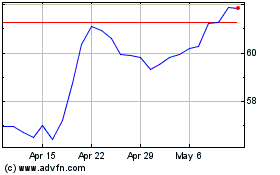Fed Limits Wells Fargo Growth, Replaces Directors -- WSJ
February 03 2018 - 3:02AM
Dow Jones News
By Ryan Tracy and Emily Glazer
This article is being republished as part of our daily
reproduction of WSJ.com articles that also appeared in the U.S.
print edition of The Wall Street Journal (February 3, 2018).
Wells Fargo & Co. will replace four board members and face
limits on growing its banking business after an unprecedented
action announced Friday by the U.S. Federal Reserve, which cited
"widespread consumer abuses."
The harsh rebuke of the third-largest U.S. bank by assets came
on the last business day of Janet Yellen's tenure as chairwoman of
the Fed. It prompted Wells Fargo's stock to fall more than 6% in
after-hours trading on Friday. The bank also said it expected the
action to reduce 2018 after-tax profit by $300 million to $400
million.
The Fed's enforcement action shows the difficulties Wells Fargo
faces in overcoming the sales-practices scandal that engulfed it in
2016. That led to a public and political uproar, the abrupt
departure of the bank's former chief executive and numerous
governmental investigations.
The Fed has never before imposed such a broad, companywide
growth restriction as part of an enforcement action, Fed officials
said. Wells Fargo is barred from growing past the $1.95 trillion in
assets it had at the end of 2017. Fed officials did say the company
can continue to lend and take deposits.
The Fed imposed the penalties after officials concluded Wells
Fargo had been growing without proper risk controls in place, the
officials said. The central bank has seen some improvement in Wells
Fargo's risk management lately but expects the bank to take further
steps, they said.
"We cannot tolerate pervasive and persistent misconduct at any
bank and the consumers harmed by Wells Fargo expect that robust and
comprehensive reforms will be put in place to make certain that the
abuses do not occur again," Ms. Yellen said in a statement.
Wells Fargo said it was "confident it will satisfy the
requirements of the consent order" that it agreed to with the
Fed.
"We take this order seriously and are focused on addressing all
of the Federal Reserve's concerns," said CEO Timothy Sloan, adding
that they referred to "prior issues where we have already made
significant progress."
Wells Fargo recently said its chief risk officer will retire in
2018 and it is also bringing in a former New York Fed official to
serve as its regulatory officer beginning in March. Both changes
occurred after months of regulatory pressure over the bank's risk
management work.
Under the Fed order, the bank agreed to tell the Fed within 60
days what it has already done and how it plans to enhance its
board's governance oversight and the bank's compliance and
operational risk management.
The Fed said the bank will also replace three current board
members by April and fourth by the end of 2018. Wells Fargo has
previously said it would add new directors to its 16-member board
in 2018, with three directors expected to retire before its April
shareholder meeting.
In September 2016, the bank settled allegations that it had
years of improper sales practices that resulted in potentially 3.5
million accounts being opened without customers' knowledge.
Elsewhere, more than 550,000 auto-loan and mortgage customers were
potentially overcharged for products for years as well.
Some members of Congress, in particular Sen. Elizabeth Warren
(D., Mass.) have called on the Fed to force the replacement of
Wells Fargo's board due to what they said were governance and
risk-management failures.
Since September 2016, Wells Fargo has replaced several board
directors. More pressure was put on the bank after its annual
shareholder meeting in April that year when nine of the bank's
directors got votes of less than 75%.
Besides the Fed, the Office of the Comptroller of the Currency
has also been weighing a new enforcement action against Wells Fargo
related to risk controls, The Wall Street Journal reported earlier
in January.
In addition to its enforcement action, the Fed also wrote
separate critical letters to former Wells Fargo chairmen John
Stumpf and Stephen Sanger. Mr. Sanger became chairman after Mr.
Stumpf left the bank in the wake of the sales-practice revelations.
Mr. Sanger had previously been the board's lead independent
director.
"Your performance ... is an example of ineffective oversight
that is not consistent with the Federal Reserve's expectations,"
wrote Michael Gibson, who directs the Fed's division of supervision
and regulation, to Mr. Sanger, who left Wells Fargo's board at the
end of 2017.
Messrs. Stumpf and Sanger didn't immediately respond to requests
for comment.
The Wall Street Journal reported earlier in January that banking
regulators downgraded one part of a secret assessment of bank's
health and strength that focuses on Wells Fargo's management and
its ability to manage risk.
The downgrade of the assessment, known as a CAMELS score,
occurred over the summer of 2017, as Wells Fargo continued to
grapple with issues related to how it treats customers.
Write to Ryan Tracy at ryan.tracy@wsj.com and Emily Glazer at
emily.glazer@wsj.com
(END) Dow Jones Newswires
February 03, 2018 02:47 ET (07:47 GMT)
Copyright (c) 2018 Dow Jones & Company, Inc.
Wells Fargo (NYSE:WFC)
Historical Stock Chart
From Mar 2024 to Apr 2024

Wells Fargo (NYSE:WFC)
Historical Stock Chart
From Apr 2023 to Apr 2024
